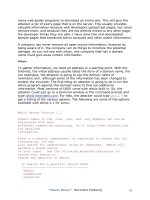The ultimate guide to react native optimization ebook callstack FINAL
Bạn đang xem bản rút gọn của tài liệu. Xem và tải ngay bản đầy đủ của tài liệu tại đây (2.26 MB, 123 trang )
The Ultimate Guide
to React Native
Optimization
Improve user experience, performance,
and stability of your apps.
Created by
2020
Table of Contents
Organizational part
Introduction to React Native Optimization
First Group
1. Pay attention to UI re-renders
2. Use dedicated components for certain layouts
3. Think twice before you pick an external library
4. Always remember to use libraries dedicated to the mobile platform
5. Find the balance between native and JavaScript
6. Animate at 60FPS no matter what
Second group
1. Always run the latest React Native version to access the new features
2. How to debug faster and better with Flipper
3. Automate your dependency management with `autolinking`
4. Optimize your Android application startup time with Hermes
5. Optimize your Android application’s size with these Gradle settings
Third Group
1. Run tests for key pieces of your app
2. Have a working Continuous Integration (CI) in place
3. Don’t be afraid to ship fast with Continuous Deployment
4. Ship OTA (Over-The-Air) when in an emergency
Thank you
Authors
Callstack
The Ultimate Guide to React Native Optimization
Organizational part
Optimizing React Native apps with a limited development budget can be
difficult but is not impossible. In such a case, you need to focus on the
essentials of your app and squeeze as much as possible out of them to
maintain your business continuity.
That’s why we prepared this guide.
In the following chapters, we will show you how to optimize the
performance and stability of your apps. Thanks to the practices
described in the guide, you will improve the user experience and speed
up the time-to-market of your apps.
The guide contains best practices for optimizing the following aspects:
― Stability
― Performance
― Resource usage
― User experience
― Maintenance costs
― Time-to-market
All these aforementioned aspects have a particular impact on the revenue-generating
effectiveness of your apps. Such elements as stability, performance, and resource
usage are directly related to improving the ROI of your products because of their
impact on better user experience. With faster time-to-market, you can stay ahead of
your competitors, whereas an easier and faster maintenance process will help you to
reduce your spendings on that particular process.
{callstack.com}
3
The Ultimate Guide to React Native Optimization
What the guide will look like and what topics it will cover.
The guide is divided into three groups:
The first group is about improving performance by understanding React Native
implementation details and knowing how to make maximum out of it. Here are the
topics we will discuss:
1. Pay attention to UI re-renders
2. Use dedicated components for certain layouts
3. Think twice before you pick an external library
4. Always remember to use libraries dedicated to the mobile platform
5. Find the balance between native and JavaScript
6. Animate at 60FPS no matter what
The second group is focused on improving performance by using the latest React
Native features or turning some of them on. This part describes the following topics:
1. Always run the latest React Native version to access the new features
2. How to debug faster and better with Flipper
3. Automate your dependency management with `autolinking`
4. Optimize your Android application startup time with Hermes
5. Optimize your Android application’s size with these Gradle settings
The third group says about improving the stability of the application by investing in
testing and continuous deployment. This part says about:
1. Run tests for key pieces of your app
2. Have a working Continuous Integration (CI) in place
3. Don’t be afraid to ship fast with Continuous Deployment
4. Ship OTA (Over-The-Air) when in an emergency
The structure of each article is simple:
Issue: The first part describes the main problem and what you may be doing wrong.
Solution: The second part says about how that problem may affect your business and
what are the best practices to solve it.
Benefits: The third part is focused on the business benefits of our proposed solution.
{callstack.com}
4
The Ultimate Guide to React Native Optimization
OK, the informational and organizational part is already covered. Now, let’s move on to
the best practices for optimizing the performance of your app.
Let’s go!
{callstack.com}
5
The Ultimate Guide to React Native Optimization
Introduction to React
Native Optimization
React Native takes care of the rendering. But
performance is still the case.
With React Native, you create components that describe how your interface should
look like. During runtime, React Native turns them into platform-specific native
components. Rather than talking directly to the underlying APIs, you focus on the user
experience of your application.
However, that doesn’t mean all applications done with React Native are equally fast and
offer same level of user experience.
Every declarative approach (incl. React Native) is built with imperative APIs. And
you have to be careful when doing things imperatively.
When you’re building your application the imperative way, you carefully analyse
every callsite to the external APIs. For example, when working in a multi-threaded
environment, you write your code in a thread safe way, being aware of the context and
resources that the code is looking for.
{callstack.com}
6
The Ultimate Guide to React Native Optimization
Despite all the differences between the declarative and imperative ways of doing things,
they have a lot in common. Every declarative abstraction can be broken down into a
number of imperative calls. For example, React Native uses the same APIs to render
your application on iOS as native developers would use themselves.
React Native unifies performance but doesn’t make it fast out of the box!
While you don’t have to worry about the performance of underlying iOS and
Android APIs calls, how you compose the components together can make all
the difference. All your components will offer the same level of performance and
responsiveness.
But is the same a synonym of the best? It’s not.
That’s when our checklist come into play. Use React Native to its potential.
As discussed before, React Native is a declarative framework and takes care of
rendering the application for you. In other words, it’s not you that dictate how the
application will be rendered.
Your job is to define the UI components and forget about the rest. However, that
doesn’t mean that you should take the performance of your application for granted.
In order to create fast and responsive applications, you have to think the React Native
way. You have to understand how it interacts with the underlying platform APIs.
If you need help with performance, stability, user experience or other
complex issues - contact us! As the React Native Core Contributors and
leaders of the community, we will be happy to help.
Hire us!
{callstack.com}
7
First Group
Improve performance by understanding
React Native implementation details.
{callstack.com}
The Ultimate Guide to React Native Optimization | First Group
Introduction
In this group, we will dive deeper into most popular performance bottlenecks and React
Native implementation details that contribute to them. This will not only be a smooth
introduction to some of the advanced React Native concepts, but also will let you
significantly improve the stability and performance of your application by performing
the small tweaks and changes.
The following article is focused on the first point from the whole checklist of the
performance optimization tactics: UI re-renders. It’s a very important part of the React
Native optimization process because it allows reducing the device’s battery usage what
translates into the better user experience of your app.
{callstack.com}
The Ultimate Guide to React Native Optimization | First Group
1. Pay attention to
UI re-renders
Optimize the number of state operations,
remember about pure and memoized
components to make your app work faster
with fewer resources needed.
Issue: Incorrect state updates cause extraneous rendering cycles / or the
device is just too slow
As discussed briefly, React Native takes care of rendering the application for you. Your job is
to define all the components you need and compose the final interface out of these smaller
building blocks. In that approach, you don’t control the application rendering lifecycle.
In other words - when and how to repaint things on screen is purely React Native’s
responsibility. React looks out for the changes you have done to your components, compares
them and, by design, performs only the required and smallest number of actual updates.
Diff
Model
Patch
Diff
Virtual DOM
{callstack.com}
DOM
10
The Ultimate Guide to React Native Optimization | First Group
The rule here is simple - by default, a component can re-render if its parent is rerendering or the props are different. This means that your component’s `render`
method can sometimes run, even if their props didn’t change. This is an acceptable
tradeoff in most scenarios, as comparing the two objects (previous and current props)
would take longer.
Negative impact on the performance, UI flicker, and FPS decrease
While the above heuristics is correct most of the time, performing too many operations
can cause performance problems, especially on low-end mobile devices.
As a result, you may observe your UI flickering (when the updates are being performed)
or frames dropping (while there’s an animation happening and an update is coming
along).
Note: You should never perform any premature optimisations. Doing so may have a
counter-positive effect. Try looking into this as soon as you spot dropped frames or
undesired performance within your app.
As soon as you see any of these symptoms, it is the right time to look a bit deeper into
your application lifecycle and look out for extraneous operations that you would not
expect to happen.
Solution: Optimize the number of state operations and remember to use
pure and memoized components when needed
There’re a lot of ways your application can turn into unnecessary rendering cycles
and that point itself is worth a separate article. In this section, we will focus on two
common scenarios - using a controlled component, such as `TextInput` and global
state.
Controlled vs uncontrolled components
Let’s start with the first one. Almost every React Native application contains at least
one `TextInput` that is controlled by the component state as per the following snippet.
{callstack.com}
11
The Ultimate Guide to React Native Optimization | First Group
import React, { Component } from ‘react’;
import { TextInput } from ‘react-native’;
export default function UselessTextInput() {
const [value, onChangeText] = React.useState(‘Text’);
return (
onChangeText={text => onChangeText(text)}
value={value}
/>
);
}
Read more: />
The above code sample will work in most of the cases. However on slow devices, and
in situation where user is typing really fast im may cause a problem with view updates.
The reason for that is simple - React Native’s asynchronous nature. To better understand
what is going on here, let’s take a look first at the order of standard operations that occur
while user is typing and populating your <TextInput /> with new characters.
Diagram that shows what happens while typing TEST
{callstack.com}
12
The Ultimate Guide to React Native Optimization | First Group
As soon as user starts inputting a new character to the native input, an update is
being sent to React Native via onChangeText prop (operation 1 on the diagram). React
processes that information and updates its state accordingly by calling setState. Next,
a typical controlled component synchronizes its JavaScript value with the native
component value (operation 2 on the diagram).
The benefit of such approach is simple. React is a source of truth that dictates the
value of your inputs. This technique lets you alter the user input as it happens, by e.g.
performing validation, masking it or completely modifying.
Unfortunately, the above approach, while being ultimately cleaner and more compliant
with the way React works, has one downside. It is most noticeable when there is
limited resources available and / or user is typing at a very high rate.
Diagram that shows what happens while typing TEST too fast
When the updates via onChangeText arrive before React Native synchronized each of
them back, the interface will start flickering. First update (operation 1 and operation 2)
perform without issues as user starts typing T.
Next, operation 3 arrives, followed by another update (operation 4). The user typed E &
S while React Native was busy doing something else, delaying the synchronisation of
the E letter (operation 5). As a result, the native input will change its value temporarily
back from TES to TE.
{callstack.com}
13
The Ultimate Guide to React Native Optimization | First Group
Now, the user was typing fast enough to actually enter another character when the
value of the text input was set to TE for a second. As a result, another update arrived
(operation 6), with value of TET. This wasn’t intentional - user wasn’t expecting the value
of its input to change from TES to TE.
Finally, operation 7 synchronized the input back to the correct input received from the
user few characters before (operation 4 informed us about TES). Unfortunately, it was
quickly overwritten by another update (operation 8), which synchronized the value to
TET - final value of the input.
The root cause of this situation lies in the order of operations. If the operation 5 was
executed before operation 4, things would have run smoothly. Also, if the user didn’t
type T when the value was TE instead of TES, the interface would flicker but the input
value would remain correct.
One of the solutions for the synchronization problem is to remove value prop from
TextInput entirely. As a result, the data will flow only one way, from native to the
JavaScript side, eliminating the synchronization issues that were described earlier.
import React, { Component, useState } from ‘react’;
import { Text, TextInput, View } from ‘react-native’;
export default function PizzaTranslator() {
const [text, setText] = useState(‘’);
return (
<View style={{padding: 10}}>
placeholder=”Type here to translate!”
onChangeText={text => setText(text)}
defaultValue={text}
/>
<Text style={{padding: 10, fontSize: 42}}>
{callstack.com}
14
The Ultimate Guide to React Native Optimization | First Group
{text.split(‘ ‘).map((word) => word && ‘
’).join(‘ ‘)}
</Text>
</View>
);
}
Read more: />
However, as pointed out by @nparashuram in his YouTube video (which is a great
resource to learn more about React Native performance), that workaround alone isn’t
enough in some cases. For example, when performing input validation or masking, you
still need to control the data that user is typing and alter what ends up being displayed
within the TextInput. React Native team is well aware of this limitation and is currently
working on the new re-architecture that is going to resolve this problem as well.
Global state
Other common reason of performance issues is how components are dependent of
the application global state. Worst case scenario is when state change of single control
like TextInput or CheckBox propagates render of the whole application. The reason for
this is bad global state management design.
We recommend using specialized libraries like Redux or Overmind.js to handle your
state management in more optimized way.
First, your state management library should take care of updating component only
when defined subset of data had changed - this is the default behavior of redux
connect function.
Second, if your component uses data in a different shape than what is stored in your
state, it may re-render, even if there is no real data change. To avoid this situation, you
can implement a selector that would memorize the result of derivation until the set of
passed dependencies will change.
{callstack.com}
15
The Ultimate Guide to React Native Optimization | First Group
import { createSelector } from ‘reselect’
const getVisibilityFilter = (state) => state.visibilityFilter
const getTodos = (state) => state.todos
const getVisibleTodos = createSelector(
[ getVisibilityFilter, getTodos ],
(visibilityFilter, todos) => {
switch (visibilityFilter) {
case ‘SHOW_ALL’:
return todos
case ‘SHOW_COMPLETED’:
return todos.filter(t => t.completed)
case ‘SHOW_ACTIVE’:
return todos.filter(t => !t.completed)
}
}
)
const mapStateToProps = (state) => {
return {
todos: getVisibleTodos(state)
}
}
const VisibleTodoList = connect(
mapStateToProps,
)(TodoList)
export default VisibleTodoList
A typical example of selectors with redux state management library
{callstack.com}
16
The Ultimate Guide to React Native Optimization | First Group
Common bad performance practice is a belief that state management library can
be replaced with usage of custom implementation that is based on React Context. It
may be handy at the beginning because it reduces boilerplate code that state manage
libraries introduce. But using this mechanism without proper memoization will lead to
huge performance drawbacks. You will probably end up refactoring state management
to redux, because it will turn out that is easier that implementation of custom selectors
mechanism to you current solution.
You can also optimize your application on single component level. Simply using Pure
Component instead of regular Component and using memo wrapper for function
components will save you a lot of re-renders. It may not have an impact at the first
glance, but you will see the difference when non-memoized components are used in list
that shows big set of data. It is usually enough as for components optimizations.
Do not try to implement these techniques in advance, because such a optimization is
used rarely and in very specific cases.
Benefits: Less resources needed, faster application
You should always keep the performance of your app in the back of your head, but do
not try to optimize everything in advance, because it usually not needed. You will end up
wasting time on solving inexistent problems.
Most of hard-to-solve performance issues are caused by bad architectural decisions
around state management, so make sure it is well designed. Particular components
should not introduce issues as long as you use Pure Component or memo wrapper.
After all, with all these steps in mind, your application should perform fewer operations
and need smaller resources to complete its job. As a result, this should lead to lower
battery usage and overall, more satisfaction from interacting with the interface.
o lower battery usage and overall, more satisfaction from interacting with the interface.
{callstack.com}
17
The Ultimate Guide to React Native Optimization | First Group
2. Use dedicated
components for certain
layouts
Find out how to use dedicated higher-ordered
React Native components to improve user
experience and performance of your apps.
Issue: You are unaware of higher-order components that are provided with
React Native
In React Native application, everything is a component. At the end of the component
hierarchy, there are so-called primitive components, such as Text, View or TextInput.
These components are implemented by React Native and provided by the platform you
are targeting to support most basic user interactions.
When we’re building our application, we compose it out of smaller building blocks. To
do so, we use primitive components. For example, in order to create a login screen, we
would use a series of TextInput components to register user details and a Touchable
component to handle user interaction. This approach is true from the very first
component that we create within our application and holds true the final stage of its
development.
{callstack.com}
18
The Ultimate Guide to React Native Optimization | First Group
On top of primitive components, React Native ships with a set of higher-order components
that are designed and optimized to serve a certain purpose.
Being unaware of them or not using them in all the places can potentially affect your
application performance, especially as you populate your state with real production data.
Bad performance of your app may seriously harm the user experience. In consequence,
it can make your clients unsatisfied with your product and turn them towards your
competitors.
Not using specialized components will affect your performance and UX as your
data grows
If you’re not using specialized components, you are opting out from performance
improvements and risking degraded user experience when your application enters
production. It is worth noting that certain issues remain unnoticed while the application
is developed, as mocked data is usually small and doesn’t reflect the size of a
production database.
Specialized components are more comprehensive and have
broader API to cover the vast majority of mobile scenarios.
Solution: Always use specialized component, e.g. FlatList for lists
Let’s take long lists as an example. Every application contains a list at some point.
The fastest and dirtiest way to create a list of elements would be to combine ScrollView
and View primitive components.
{callstack.com}
19
The Ultimate Guide to React Native Optimization | First Group
However, such an example would quickly get into trouble when the data grows. Dealing
with the large data-sets, infinite scrolling, and memory management was the motivation
behind FlatList - a dedicated component in React Native for displaying and working with
data structures like this. Compare performance of adding new list element based on
ScrollView,
import React, { Component, useCallback, useState } from ‘react’;
import { ScrollView, View, Text, Button } from ‘react-native’;
const objects = [
[‘avocado’, ‘
’],
[‘apple’, ‘
’],
[‘orage’, ‘
’],
[‘cactus’, ‘
’],
[‘eggplant’, ‘
’],
[‘strawberry’, ‘
[‘coconut’, ‘
’],
’],
];
const getRanomItem = () => {
const item = objects[~~(Math.random() * objects.length)];
return {
name: item[0],
icon: item[1],
id: Date.now() + Math.random(),
};
};
const _items = Array.from(new Array(5000)).map(() => getRanomItem());
export default function List() {
const [items, setItems] = useState(_items);
const addItem = useCallback(() => {
setItems([getRanomItem()].concat(items));
{callstack.com}
20
The Ultimate Guide to React Native Optimization | First Group
}, [items]);
return (
<View style={{marginTop: 20}}>
<Button title=”add item” onPress={addItem} />
<ScrollView>
{items.map(({name, icon}) => (
borderWidth: 1,
margin: 3,
padding: 5,
flexDirection: ‘row’,
}}>
<Text style={{ fontSize: 20, width: 150 }}>{name}</Text>
<Text style={{ fontSize: 20 }}>{icon}</Text>
</View>
))}
</ScrollView>
</View>
);
}
Read more: />
to list based on FlastList.
import React, { Component, useCallback, useState } from ‘react’;
import { View, Text, Button, FlatList, SafeAreaVie } from ‘react-native’;
const objects = [
[‘avocado’, ‘
’],
[‘apple’, ‘
’],
[‘orage’, ‘
’],
[‘cactus’, ‘
{callstack.com}
’],
21
The Ultimate Guide to React Native Optimization | First Group
[‘eggplant’, ‘
’],
[‘strawberry’, ‘
[‘coconut’, ‘
’],
’],
];
const getRanomItem = () => {
const item = objects[~~(Math.random() * objects.length)].split(‘ ‘);
return {
name: item[0],
icon: item[1],
id: Date.now() + Math.random(),
};
};
const _items = Array.from(new Array(5000)).map(() => getRanomItem());
export default function List() {
const [items, setItems] = useState(_items);
const addItem = useCallback(() => {
setItems([getRanomItem()].concat(items));
}, [items]);
return (
<View style={{ marginTop: 20 }}>
<Button title=”add item” onPress={addItem} />
keyExtractor={({ id }) => id}
renderItem={({ item: { name, icon } }) => (
borderWidth: 1,
margin: 3,
padding: 5,
{callstack.com}
22
The Ultimate Guide to React Native Optimization | First Group
flexDirection: ‘row’,
}}>
<Text style={{ fontSize: 20, width: 150 }}>{item[0]}</Text>
<Text style={{ fontSize: 20 }}>{item[1]}</Text>
</View>
)}
/>
</View>
);
}
Read more: />
The difference is significant, isn’t it? In provided example of 5000 list items, ScrollView
version does not even scroll smoothly.
At the end of the day, FlatList uses ScrollView and View components as well - what’s the
deal then?
Well, the key lies in the logic that is abstracted away within the FlatList component. It
contains a lot of heuristics and advanced JavaScript calculations to reduce the amount
of extraneous renderings that happen while you’re displaying the data on screen and to
make the scrolling experience always run at 60 FPS.
Just using FlatList may not be enough in some cases. FlatList performance
optimizations relay on not rendering elements that are currently not displayed on
the screen. The most costly part of the process is layout measuring. FlatList has to
measure your layout to determine how much space in scroll area should be reserved
for upcoming elements.
For complex list elements it may slow down interaction with flat list significantly.
Every time FlatList will approach to render next batch of data it will have to wait for all
new items to render to measure their height.
{callstack.com}
23
The Ultimate Guide to React Native Optimization | First Group
However you can implement getItemHeight() to define element height up-front without
need for measurement. It is not straight forward for items without constant height. You
can calculate the value based on number of lines of text and other layout constraints.
We recommend using react-native-text-size library to calculate height of displayed text
for all list items at once. In our case it significantly improved responsiveness for scroll
events of FlatList on android.
Benefits: Your app works faster, displays complex data structures and you
opt-in for further improvements
Thanks to using specialized components, your application will always run as fast as
possible. You automatically opt-in to all the performance optimisations done by the
React Native so far and subscribe for further updates to come.
At the same time, you also save yourself a lot of time reimplementing most common
UI patterns from the ground up. Sticky section headers, pull to refresh - you name it.
These are already supported by default, if you choose to go with FlastList.
{callstack.com}
24
The Ultimate Guide to React Native Optimization | First Group
3. Think twice before you
pick an external library
How working with the right JavaScript
libraries can help you boost the speed and
performance of your apps.
Issue: You are choosing libraries without checking what is inside
JavaScript development is like assembling the applications out of smaller blocks. To a
certain degree, it is very similar to building React Native apps. Instead of creating React
components from scratch, you are on the hunt for the JavaScript libraries that will help
you achieve what you had in mind. The JavaScript ecosystem promotes such approach to
development and encourages structuring applications around small and reusable modules.
This type of ecosystem has many advantages, but also some serious drawbacks. One
of them is that developers can find it hard to choose from multiple libraries supporting
the same use case.
{callstack.com}
25









